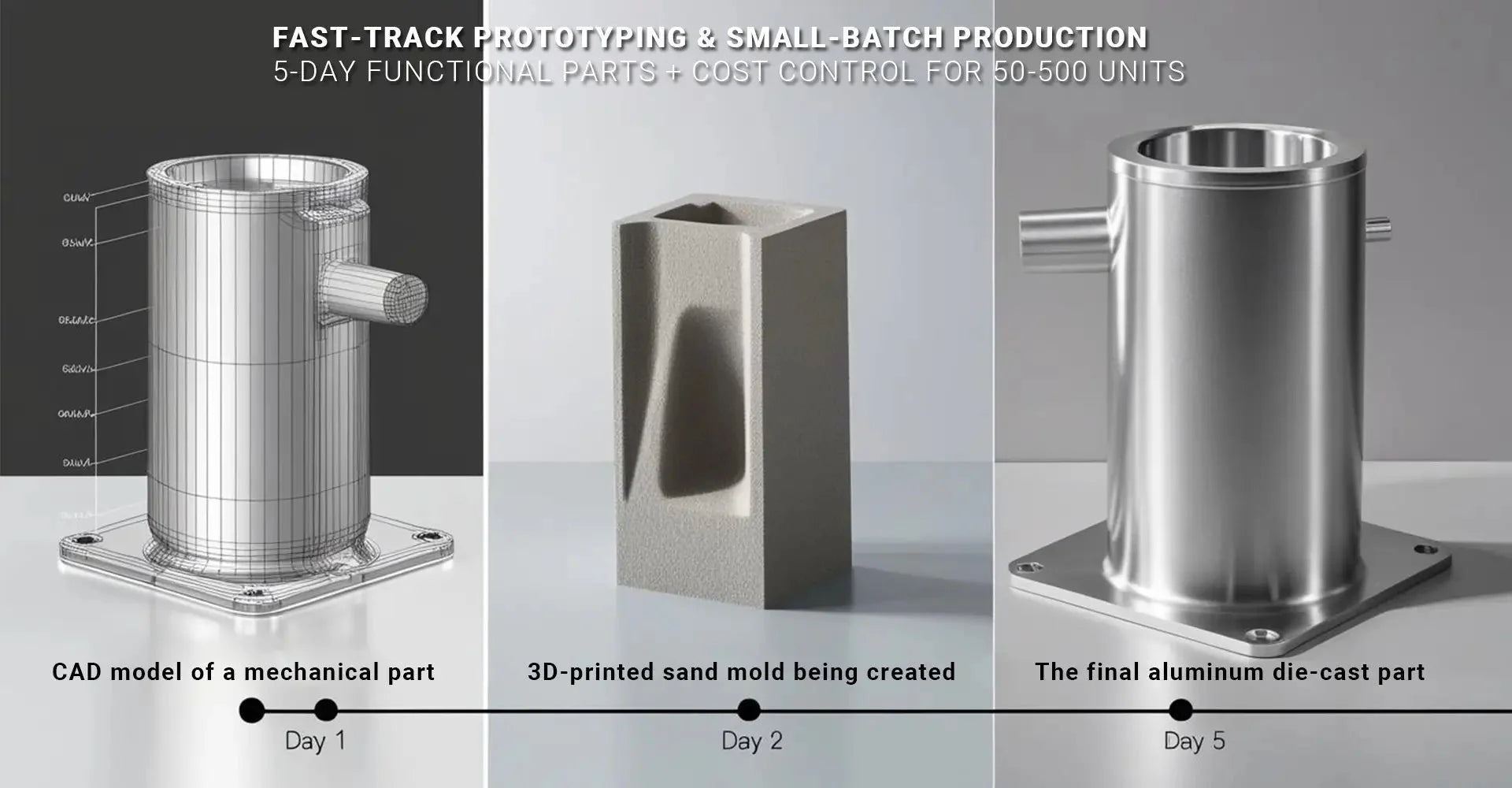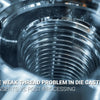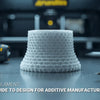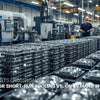Fast-Track Prototyping Small-Batch Production: 5-Day Functional Parts + Cost Control for 50-500 Units

Fast-Track Prototyping & Small-Batch Production: 5-Day Functional Parts + Cost Control for 50-500 Units
How Can You Get Functional Die-Cast Prototypes in Just 5 Days?

Engineers and product developers facing tight deadlines need rapid, reliable prototyping solutions that deliver functional parts without compromising quality. The innovative combination of 3D printed molds with traditional die casting now makes it possible to receive fully functional aluminum prototypes in just 5 days – a process that traditionally takes weeks or even months.
Quick Answer: Get functional die-cast prototypes in 5 days using hybrid 3D-printed mold technology with ±0.15mm accuracy. This approach is ideal for small production runs (50-500 units) with 60% lower upfront costs compared to traditional tooling methods. Perfect for product validation before committing to mass production.
Whether you're a startup finalizing your product design or an established manufacturer exploring new components, this guide examines how hybrid 3D printing + die casting for fast tooling techniques are changing the game for rapid prototyping and low-volume production services. Let's explore the specific processes, benefits, and real-world applications that make this approach valuable for your next project.
[Table Of Contents]
- How Does 3D-Printed Mold Technology Work with Die Casting?
- How Did One Startup Validate Their Product Design in Less Than a Week?
- What Cost-Saving Strategies Work Best for Small Production Runs?
- Which Surface Finish Options Provide the Best Value?
- How Can You Transition Smoothly from Prototype to Mass Production?
How Does 3D-Printed Mold Technology Work with Die Casting?
The breakthrough in rapid prototyping comes from combining advanced SLA-printed sand molds with traditional aluminum die casting techniques. This hybrid approach creates functional metal parts with production-grade properties in a fraction of the time. The process leverages the speed of 3D printing while maintaining the mechanical integrity and surface quality associated with conventional die casting.
Key Process Details: The 5-day timeline breaks down into three main phases: 3D-printed sand mold creation (24 hours), high-pressure die casting with aluminum alloys like A380 (48 hours), and robotic deburring and finishing (24 hours). This process achieves impressive dimensional accuracy of ±0.15mm, making these prototypes suitable for form, fit, and functional testing.

Unlike traditional steel molds that require weeks of CNC machining, these specialized sand molds are printed directly from CAD files, eliminating extensive tooling lead times. Moreover, the binder jetting technology used in creating these molds can withstand pour temperatures exceeding 700°C, making them compatible with various aluminum alloys and even high-temperature materials like AZ91D magnesium. Each batch produced includes complete material certifications with Mill Test Reports (MTRs) and ASTM E8 tensile test data to verify mechanical properties, ensuring 5-day functional die-cast prototypes with 3D printed molds meet the same quality standards as production components.
How Did One Startup Validate Their Product Design in Less Than a Week?
A tech startup developing an IoT-connected coffee grinder needed functional prototypes to secure their next round of funding. Their challenge: create 50 working units for investor demos and beta testing without depleting their limited capital on expensive tooling. The traditional approach would have required weeks of waiting and significant upfront investment.
Case Study Results: Using the hybrid rapid prototyping approach, the startup received 50 functional die-cast aluminum housings within 5 days. The parts featured a smooth Ra 1.6μm surface finish, perfect for demonstrating the premium feel of their product. This accelerated timeline allowed them to complete user testing, make design refinements, and present working prototypes to investors – all within two weeks of finalizing their CAD files.

The startup's success hinged on the comprehensive validation process enabled by these functional prototypes. After receiving the initial batch, they conducted drop tests, thermal cycling, and assembly verification using actual electronic components. The aluminum die casting for 50-unit minimum orders performed nearly identically to production-intent components, with similar weight, thermal conductivity, and structural integrity. This real-world testing identified two critical design issues that would have been expensive to correct during mass production. With these insights, they refined their design and produced a second small batch before committing to full-scale manufacturing, ultimately saving approximately $45,000 in tooling modification costs and preventing a potential three-month delay in their product launch.
What Cost-Saving Strategies Work Best for Small Production Runs?
Small-batch production (50-500 units) traditionally falls into a challenging middle ground – too large for economical 3D printing but too small to justify expensive hard tooling. However, several strategic approaches now make these production volumes not just feasible but highly cost-effective when using hybrid manufacturing methods.
Four Proven Strategies: 1) Multi-cavity mold sharing splits costs across multiple clients, reducing per-part expenses by up to 40%. 2) Using recycled aluminum provides 30% material cost savings without compromising quality. 3) AI-driven CNC trimming decreases post-processing time by 20%. 4) Standardized packaging options eliminate the need for custom boxing solutions, further reducing overall project costs.
When comparing overall economics, the hybrid approach demonstrates significant advantages. The upfront costs are approximately 60% lower than traditional steel tooling, primarily because no permanent molds need to be created. At volumes around 50 units, the per-part cost typically ranges from $25-45 (depending on size and complexity), compared to $80-120 for CNC machining. Furthermore, the crossover point where traditional tooling becomes more economical typically occurs around 500-700 units, making cost-effective small batch manufacturing (50-500 units) ideal for product validation runs, market testing, or specialized low-volume applications. Additionally, the staged investment approach allows companies to allocate capital progressively as market validation increases, rather than committing large sums upfront for tooling that might require modifications after initial feedback.
Which Surface Finish Options Provide the Best Value?
Surface finish quality plays a crucial role in prototype evaluation, affecting both aesthetic appeal and functional performance. The rapid prototyping process offers several finishing options that balance speed, cost, and quality considerations depending on your specific requirements.
Finish Comparison: For fastest turnaround, bead blasting provides Ra 3.2μm surface roughness in just 4 hours at minimal cost. For production-equivalent appearance, hardcoat anodizing delivers a premium Ra 0.8μm finish in 48 hours. Textured surfaces fall between these options, requiring approximately 24 hours of processing time while offering excellent tactile properties for consumer products.

Beyond basic finishing options, specialized treatments can address specific functional requirements. For parts requiring enhanced wear resistance, hard anodizing can increase surface hardness to 60-70 HRC (comparable to hardened steel), though this adds approximately 36 hours to the timeline. Similarly, chemical conversion coatings improve corrosion resistance with minimal dimensional impact, adding only 12-16 hours to the process. For cosmetic prototypes that need to match production appearance exactly, specialized painting and powder coating options are available, though these typically extend the timeline by an additional 24-48 hours. When selecting a finish, consider balancing immediate needs for rapid surface finishing for prototype validation against the specific testing requirements – many clients opt for minimal finishing on initial prototypes, then request production-equivalent finishes on subsequent small-batch runs once the design is validated.
How Can You Transition Smoothly from Prototype to Mass Production?
One of the greatest challenges in product development occurs during the transition from prototyping to mass production. The hybrid tooling approach creates a smoother pathway by generating valuable data and experience that directly transfers to production tooling design for industrial machinery and consumer products alike.
Transition Benefits: The hybrid prototyping process allows reuse of approximately 70% of prototype mold data when designing production tooling. This continuity reduces scale-up risks significantly, as flow characteristics, gate locations, and cooling requirements identified during prototyping inform the final tool design. ISO 9001-certified low-volume manufacturing ensures all processes maintain consistent quality standards throughout the transition.
The data collected during small-batch production provides invaluable insights that traditional prototyping methods cannot offer. Flow analysis from actual die casting runs helps optimize gate locations and minimize porosity in production tools. Actual cycle times provide accurate costing data for large-scale manufacturing planning. Even subtle aspects like material shrinkage rates and optimal ejection mechanisms can be precisely calibrated based on real production experience rather than theoretical calculations. This smooth transition capability is particularly valuable for companies planning staged market rollouts – they can begin with 50-100 units for limited release, expand to 300-500 units for broader market testing, then scale directly to mass production using bridging tooling solutions for pilot production. This approach significantly reduces the "production surprise" problems that often occur when moving from prototype to manufacturing.
Conclusion
The innovative combination of 3D printed molds with traditional die casting techniques has created a powerful new option for product developers needing functional prototypes and small production runs. With 5-day turnaround times, cost-effective production for 50-500 units, and a smooth pathway to mass manufacturing, this approach fills a critical gap in the product development process.
By leveraging this hybrid manufacturing approach, companies can now validate designs with functional metal parts in days rather than weeks, control costs during critical early production phases, and gather real-world production data before committing to expensive hard tooling. Whether you're a startup launching your first product or an established manufacturer exploring new designs, this rapid prototyping and small-batch production capability provides valuable flexibility and speed in today's competitive market.
[External Links Recommendation]
[Rapid prototyping and low-volume production services][^1]
[5-day functional die-cast prototypes with 3D printed molds][^2]
[Cost-effective small batch manufacturing (50-500 units)][^3]
[Hybrid 3D printing + die casting for fast tooling][^4]
[Rapid surface finishing for prototype validation][^5]
[ISO 9001-certified low-volume manufacturing][^6]
---
[^1]: Explore this link to understand how rapid prototyping can accelerate product development and reduce costs.
[^2]: Discover how 3D printed molds can significantly reduce lead times in prototyping processes.
[^3]: Learn about the benefits of small batch manufacturing for startups and businesses looking to minimize costs.
[^4]: Explore this link to understand how combining these technologies can enhance production efficiency and reduce lead times.
[^5]: Discover the importance of rapid surface finishing in validating prototypes quickly and effectively, ensuring better product development.
[^6]: Learn about ISO 9001 certification and how it ensures quality in low-volume manufacturing processes, crucial for maintaining standards.
-
Posted in
aluminum die casting





